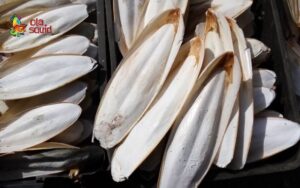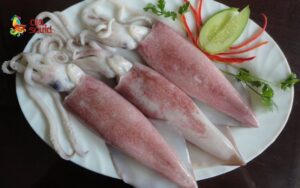Among the popular dried squid products on the market, there is a name that sparks curiosity for many and causes hesitation when choosing: dried squid xà. Some people believe that dried squid xà is poisonous and harmful to health. Others affirm that it is a delicious, cheap type of squid, suitable for rustic drinking sessions. So, what exactly is dried squid xà? Is it poisonous? The following article will help you answer all the questions surrounding this type of squid.
1. What is dried cuttlefish?
Dried cuttlefish (also known as dried squid ma) is a type of squid that is large in size, thick-bodied, and has dark brown skin. This squid species is typically caught in offshore waters, especially in the central coastal regions of Vietnam such as Da Nang, Quang Ngai, Binh Dinh, etc., as well as in the waters of Hoang Sa and Truong Sa. Squid xà is characterized by its large, fan-shaped tail like a fish fin and thick flesh, but it has a rather bland taste, even a slight sourness when chewed thoroughly, and the meat is a bit tough.

After being caught, the squid is usually frozen and dried for preservation and transportation to consumers. This squid species forages day and night, and especially during the rough sea season from December to the end of September each year, this is when the squid appears most frequently.
2. Is dried cuttlefish poisonous?
The answer is no, dried squid xà is completely non-toxic if processed and preserved correctly. Many people mistakenly believe this type of squid is harmful due to its dark color, thick flesh, and tendency to have a fishy odor or a slightly pungent taste if not cooked properly. In reality, these characteristics are only due to its habitat 800 meters deep in the sea and the freezing process after being caught offshore.
The concern does not lie with the squid itself, but with the way it is prepared, dried, and stored. Some establishments, in order to improve the color and extend shelf life, soak dried squid xà in chemicals or dye it, causing consumer anxiety and spreading inaccurate rumors.
Furthermore, due to its resemblance to squid lá, dried squid ma is sometimes mixed in and sold at higher prices. Therefore, you should observe and choose carefully when buying squid to avoid confusion.
3. Current price of dried cuttlefish
On the market, the price of dried squid xà currently ranges from VND 300,000 to VND 500,000 per kilogram for the type with 2-3 squid per kilogram. For places that import in large quantities or dry it manually, the price may be lower. This is why dried squid ma is often considered a more economical choice compared to premium dried squid varieties like squid ống or squid lá.

However, you need to be wary of unusually cheap dried squid products, especially advertisements for dried squid lá costing only VND 400,000 – VND 500,000 per kilogram. In reality, fresh squid lá already costs about VND 180,000 – VND 250,000 per kilogram, so if dried squid lá is too cheap, it is very likely to be dried squid ma disguised as squid lá.
4. How to prepare dried cuttlefish
Similar to other types of dried squid, dried squid xà can also be prepared into dishes such as:
- Grilled dried squid xà: No need for fuss, just with a charcoal grill or an electric oven, dried squid xà is grilled to a fragrant aroma, with a lightly charred surface, while retaining its natural sweetness and chewiness inside.
- Squid stir-fried with tamarind: Dried squid xà, after being rehydrated, is cut into bite-sized pieces and stir-fried with a sweet and sour tamarind sauce, with some fried garlic and fresh chili. The sourness of the tamarind blends with the chewy sweetness of the squid to create a rich dish.
- Squid stir-fried with sa tế: For those who love spicy flavors, squid stir-fried with sa tế is a must-try dish. Dried squid xà is rehydrated, quickly stir-fried with sa tế, garlic, onions, and a little fish sauce and sugar to enhance the flavor.
- Fried rice with dried squid: This dish offers a novelty thanks to the distinctive aroma and chewy texture of shredded squid. The dish is often combined with eggs, scallions, and a little fish sauce to bring out the flavor, suitable for a quick meal that is still nutritious and appealing.
5. Notes when choosing a place to buy dried cuttlefish
Although dried squid xà is not as sweet and chewy as squid lá or squid ống, its competitive price makes this type of squid increasingly popular on the market. However, this popularity also brings many risks when buying from unreliable sources. To avoid purchasing substandard products, you need to pay attention to the following points:
- Proper storage of dried squid: The ideal storage temperature is -18°C to maintain its sweetness, chewiness, and natural flavor. Avoid buying squid that has been stored for too long at room temperature or whose storage conditions are unclear.
- Check the powdery layer on the body: Good squid usually has a thin, light white powdery layer evenly covering the surface. If there is no powder or an abnormally thick powdery layer, be careful as the squid may have been processed.
- Adhesion between the body and the head of the squid: The body and head of the squid being tightly attached naturally indicates that the squid was prepared from a fresh specimen and not thawed multiple times. If the head is loose and easily falls off, it is highly likely that the squid is old or improperly stored.
- Feel the dryness and smell of the squid: Squid is up to standard when it is not sticky to the touch, not damp, and has a dry surface. The squid should have a fresh, light aroma, not a strong fishy smell or signs of mold.
The article above provides detailed information about dried cuttlefish, and we hope it has helped you answer the questions at the beginning of the article and understand more about this type of dried squid. And to discover more fascinating information about dried squid, preparation methods, selection tips, etc., don’t forget to visit the Blog section of Ola Squid!


 Tiếng Việt
Tiếng Việt ไทย
ไทย




